IO流
一,什么是IO?
I:Input
O:Output
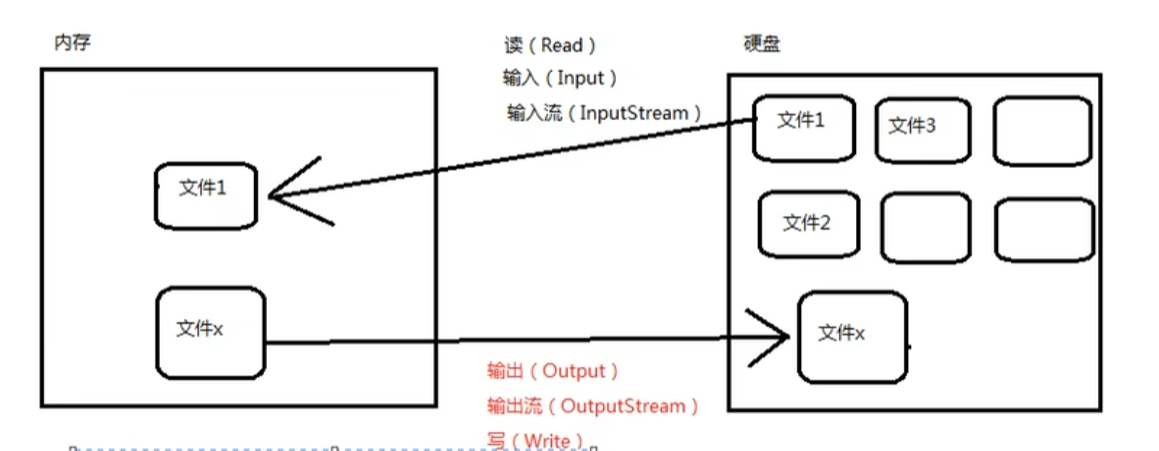
是内存与硬盘之间的关系;
二,IO流如何分类呢?
有两种分法:
第一种:按照流的方向进行分类:
去内存里,叫做输入,(Input),或者叫做'读';
从内存中出来,叫做输出(Output),也可以叫做‘写’;
第二种:按照读取数据方式不同进行分类;
(1)按照字节的方式读取数据,一次读取一个字节byte(==8个二进制),这种流是万能的,图像,声音,文本文件都可以读取。
Eg:
“冷薄的KD”
第一次读取半个‘冷’,中文占2个字节
K占一个字节
(2) 按照字符的方式读取数据,一次读取一个字符,这种流为了方便读取文本TXT,而存在的,除了TXT格式以外的都不能读取,包括Word文档。
Eg:
“冷薄的KD”
第一次读取的就是‘冷’字符;
第二次读取的就是‘薄’字符;
总结:
IO流分为:
输入流、输出流;
字节流、字符流;
’
需要掌握:JAVA中的IO流有哪些?分别有什么特点?存在的意义是什么?
三,JAVA IO流 四大家族:
leader:(都是抽象类 abstract class)
java.io.Inputstream 字节输入流
java.io.outputstream 字节输出流
java.io.Reader 字符输入流
java.io.Writer 字符输出流
Close()和flush()
所有流都实现了 java.io.Closeable 接口,都是可关闭的,都有close()方法
流是内存与硬盘之间的管道,用完一定要关闭,否则会占用资源!!
所有输出流都实现了java.io.Flushable接口,都是可刷新的,都有flush方法
养成输出流输出完毕后使用flush的好习惯,flush意味着将管道里所有数据强行输出完(清空管道)
刷新的作用就是清空管道
PS:只要是stream结尾的都是字节流,Reader或Writer结尾是字符流
如果没有flush()可能会导致数据丢失
四:16个java.io需要掌握的流
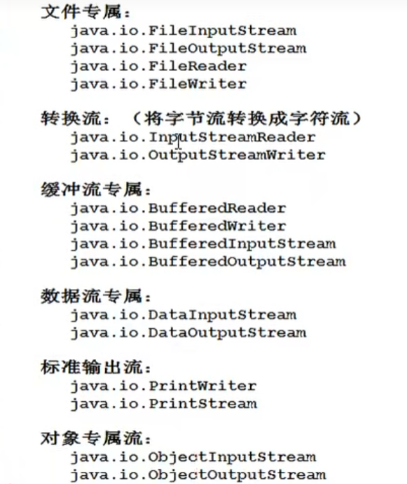
4.1:java.io.FileInputStream(文档输入流)
需掌握方法:
fil.read();//读取一个字节,每次使用该方法时会自动跳到下一个字节。
fil.close();//关闭流,一般在finally{}使用;

fil.available(); //查看剩下多少字节没读可以与byte数组连用:
byte [ ] bytes =new byte[fil.available()];
但是不适合太大文件因为byte数组有限,并且很难在堆中找到连续的大空间 ![]()
fil.skip();//跳过几个字节不读取
package IOtext;
import java.io.FileInputStream;
import java.io.FileNotFoundException;
import java.io.IOException;
public class FileInputstreamtext02 {
public static void main(String[] args) {
FileInputStream fil=null;
try {
fil=new FileInputStream("D:\\java\\javatext\\out\\production\\javatext\\text.txt");
byte []bytes=new byte[4];
int a=0;
while ((a=fil.read(bytes))!=-1)//改进,使用byte数组来输入字节,效率更高效。
{
//这里bytes读了多少个就转了多少个字节
System.out.println(new String(bytes,0,a));
}
} catch (IOException e) {
throw new RuntimeException(e);
}finally {
try {
if (fil != null) {
fil.close();
}
} catch (IOException e) {
throw new RuntimeException(e);
}
}
}
}
4.2 java.io.FileOutputstream(文档输出流)//o流与I流不同的点,try,写后最后要加个fil.flush();
package IOtext; import java.io.FileOutputStream; import java.io.IOException; public class FileOutputstreamtext01 { public static void main(String[] args) { FileOutputStream fileOutputStream=null; try { fileOutputStream=new FileOutputStream("myfile.txt",true);//append是追加的意思,不会将文档里的内容覆盖 String a="今天天气真好!!"; byte[]b=a.getBytes();//将String转成byte数组 fileOutputStream.write(b); fileOutputStream.flush(); } catch (IOException e) { throw new RuntimeException(e); }finally { try { if (fileOutputStream != null) { fileOutputStream.close(); } } catch (IOException e) { throw new RuntimeException(e); } } } }
package IOtext; import java.io.FileInputStream; import java.io.FileNotFoundException; import java.io.FileOutputStream; import java.io.IOException; public class FileOutputstreamtext02 { public static void main(String[] args) { FileOutputStream fol=null; FileInputStream fil=null; try { fil=new FileInputStream("C:\\Users\\lengbo\\Desktop\\text.txt"); fol=new FileOutputStream("D:\\text.txt",true); byte []a=new byte[1024*1024]; int reread=0; while ((reread=fil.read(a))!=-1)//循环拷贝 { fol.write(a,0,reread); } fil.read(a); fol.flush(); } catch (IOException e) { throw new RuntimeException(e); }finally { if (fil != null) { try { fil.close(); } catch (IOException e) { throw new RuntimeException(e); } } if (fol != null) { try { fol.close(); } catch (IOException e) { throw new RuntimeException(e); } } } } }
字符形式:Reader与Writer
package IOtext; import java.io.FileNotFoundException; import java.io.FileReader; import java.io.FileWriter; import java.io.IOException; public class FileWritertext02 { public static void main(String[] args) { FileReader in=null; FileWriter out=null; try { in=new FileReader("text.txt"); out=new FileWriter("C:\\text.txt");//加复制的文件名!!! int arrtemp=0; char []a=new char[4]; while ((arrtemp=in.read(a))!=-1) { out.write(a,0,arrtemp); } out.flush(); } catch (IOException e) { throw new RuntimeException(e); }finally { if (in != null) { try { in.close(); } catch (IOException e) { throw new RuntimeException(e); } } if (out != null) { try { out.close(); } catch (IOException e) { throw new RuntimeException(e); } } } } }
package IOtext; import java.io.FileNotFoundException; import java.io.FileReader; import java.io.IOException; public class FileReadertext01 { public static void main(String[] args) { FileReader fileReader=null; try { fileReader=new FileReader("text.txt"); char []a=new char[4];//char[]!!!!!区别 int reread=0; while ((reread=fileReader.read(a))!=-1) { System.out.println(new String(a,0,reread)); } } catch (IOException e) { throw new RuntimeException(e); }finally { try { if (fileReader != null) { fileReader.close(); } } catch (IOException e) { throw new RuntimeException(e); } } } }
没啥好说的,fil.Writer();可以在里面写字符串“xxx”;
---------------------------------File文档就到这里了----------总结-----------------------------------------------------------------------------------------------------------------------------------------------------------------------------------------------
file类型,无论是Intput还是Output,无论是Reader还是Writer,都是固定格式,只是本质上有些区别!!一个是字节输入,一个是字符输入,在拷贝文件的时候都需要byte数组,char数组,这样效率比循环一个一个的更高!
能用记事本打开编辑的,都是.txt文件
--------------------------------------------------------------------------------------------------------------------------------------------------------------------------------------------------------------------------------------------------------------------------
4.5 java.io.BufferedReader(缓冲流)//不需要定义数组了,只需要一个reader;
package IOtext; import java.io.BufferedReader; import java.io.FileNotFoundException; import java.io.FileReader; import java.io.IOException; public class BufferedReadertext01 { public static void main(String[] args) { FileReader reader= null; try { reader = new FileReader("text.txt"); BufferedReader b=new BufferedReader(reader); String a=null; while ((a=b.readLine())!=null) { System.out.println(a); } } catch (IOException e) { throw new RuntimeException(e); }finally { try { if (reader != null) {//关最外边的流!!这写错了 reader.close(); } } catch (IOException e) { throw new RuntimeException(e); } } } }
4.6 BufferInputStream和BufferOutputStream
与Reader和Writer一样;见上
4.8InputStreamReader与OutputStreamWriter(转换流)//将字节型转为字符型
可与Buffer连用,父类是Reader/Writer;
InputStreamReader:
以下代码抛出异常,并不是不需要写!!!!
package IOtext import java.io.*; public class BufferedReaderText02 { public static void main(String[] args) throws Exception{ FileInputStream reader=null; BufferedReader reader1=new BufferedReader(new InputStreamReader(new FileInputStream("text.txt")));//套娃 String a=null; while ((a=reader1.readLine())!=null) { System.out.println(a); } reader1.close(); } }
OutputStreamWriter:
以下代码抛出异常,并不是不需要写!!!!
package IOtext; import java.io.*; public class BufferWriterText01 { public static void main(String[] args) throws Exception{ BufferedWriter writer=new BufferedWriter((new OutputStreamWriter(new FileOutputStream("text.txt",true)))); writer.write("加油!!!!!!!!!!"); writer.close(); } }
4.9 java.io.DataInputStream(数据字节输入流)//数据专属流 不用DataInputStream读无法打开
用DataInputStream输入的只能用DataOutputStream输出,不然看的是乱码,并且输入的基本类型要与输入时的顺序一致。
in
package IOtext; import java.io.*; public class DataInputStreamText01 { public static void main(String[] args) throws Exception{ DataInputStream d=new DataInputStream(new FileInputStream("OutText.txt")); int a=d.readInt(); float f=d.readFloat(); System.out.println(a); System.out.println(f); } }
Out
package IOtext; import java.io.DataInputStream; import java.io.DataOutputStream; import java.io.FileInputStream; import java.io.FileOutputStream; public class DataOutputStreamText01 { public static void main(String[] args) throws Exception{ DataOutputStream d1=new DataOutputStream(new FileOutputStream("OutText.txt")); int a=10; float f=3.14F; d1.writeInt(a); d1.writeFloat(f); d1.flush(); d1.close(); } }
4.10 java.io.PrintStream(标准输出流)//梦回开始的地方!
package IOtext; import java.io.PrintStream; public class PrintStreamText01 { public static void main(String[] args) { PrintStream p=new PrintStream(System.out); p.println("我喜欢下雨"); } }
PrintStream p=new PrintStream(new PrintStream("text.txt"));//更改方向
package IOtext; import java.io.PrintStream; public class PrintStreamText01 { public static void main(String[] args) throws Exception{ //更改输出流方向,输出流不再指向控制台,指向text文件 PrintStream p=new PrintStream(new PrintStream("text.txt")); p.println("我喜欢下雨"); } }
*******************************************************************************************************************************
插入:
回顾:
System.exit(0);//退出
System.currentTimeMillis();//打印1980-现在的毫秒数
System.arraycopy();//数组拷贝
*******************************************************************************************************************************
日志文件怎么写?
package IOtext; import java.io.FileNotFoundException; import java.io.FileOutputStream; import java.io.PrintStream; import java.text.SimpleDateFormat; import java.util.Date; public class Logger { public static void log(String a){ try { //创建标准输出流 PrintStream p=new PrintStream(new FileOutputStream("loge.txt",true)); //.setOut是更改输出流方向,默认在控制台上 System.setOut(p);// //创建日期类 Date nowTime=new Date(); //定义日期格式 SimpleDateFormat sdf=new SimpleDateFormat("yyyy-MM-E-dd HH:mm:ss SSS"); //用字符串接受 String time=sdf.format(nowTime); //输出格式 System.out.println(time+":"+a); } catch (FileNotFoundException e) { throw new RuntimeException(e); } } }
随便整个类 new试一下就OK
package IOtext; public class Logetext01 { public static void main(String[] args) { Logger.log("最后执行时间"); } }
loge.TXT;(执行了好几遍的结果)

//建议去看看日期格式这么写的,见日期随笔
5 File类
5.1File和四大家族没有关系,所以File不能读和写
5.2File对象是什么?
文件和目录路径名的抽象表示形式。
D:\BcutBilibili\素材//这是就是一个File对象
5.3 File中需要掌握的常用方法:
File f=new File();
f.exists();//判断是否存在该文件,布尔类型,默认false。
f.createNewFile();//以文件的形式创建
f.mkdir();//以目录的形式创建
f.mkdirs();//以多重目录的形式创建
String parentPath=f.getParent();//上一级,父
File f1=f.getAbsoluteFile();//fill型的绝对路径
f.getAbsolutePath());//String
f.getAbsoluteFile());//File
f.lenth();//长度
File [ ] f=f.listFiles();//获取当前目录所有子文件
for(File a : files{sout{f.getName};//foreach
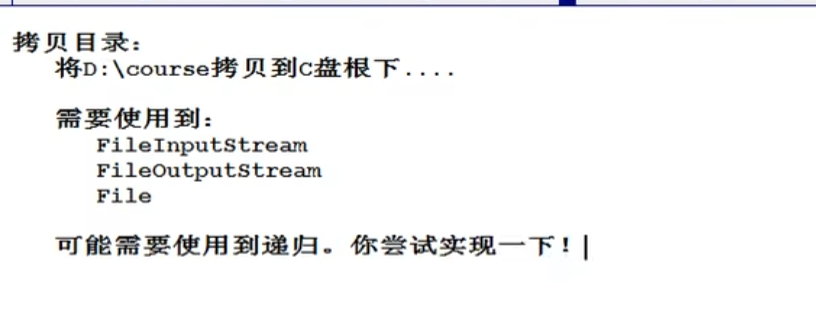
Work
import java.io.*; public class FileclassWork01 { public static void main(String[] args) { File a = new File("D:\\a\\b\\c\\d"); File b = new File("C:\\"); copyDir(a, b); } private static void copyDir(File a, File b) { if (a.isFile()) { FileInputStream in = null; FileOutputStream out = null; try { in = new FileInputStream(a); String path = (b.getAbsolutePath().endsWith("\\") ? b.getAbsolutePath() : b.getAbsolutePath() + "\\") + a.getAbsolutePath().substring(3); out = new FileOutputStream(path); byte[] bytes = new byte[1024 * 1024]; int temp = 0; while ((temp = in.read(bytes)) != -1) { out.write(bytes, 0, temp); } out.flush(); } catch (IOException e) { throw new RuntimeException(e); } finally { if (out != null) { try { out.close(); } catch (IOException e) { throw new RuntimeException(e); } } if (in != null) { try { in.close(); } catch (IOException e) { throw new RuntimeException(e); } } } return; } File[] files = a.listFiles(); for (File f : files ) { if (f.isDirectory()) { String a1 = f.getAbsolutePath(); String b1 = (b.getAbsolutePath().endsWith("\\") ? b.getAbsolutePath() : b.getAbsolutePath() + "\\") + a1.substring(3); File file1 = new File(b1); if (!file1.exists()) { file1.mkdirs(); } } copyDir(f, b); } } }
4.15 序列化与反序列化
什么是序列化(Serialize)?or反序列化(DeSerialize)????

对象从内存到硬盘文件的过程就叫序列化,因为管道大小有限,它将对象分成一块一块的,就想切豆腐一样,才能放入硬盘中。反之,硬盘到内存的过程就是反序列化

Serializable接口是一个标志接口,jvm看见这个类实现了这个接口,可能会对这个类进行特殊待遇。
当jvm看见Serializable接口后,会给该类自动生成一个序列化版本号。
怎么写呢?
//序列化
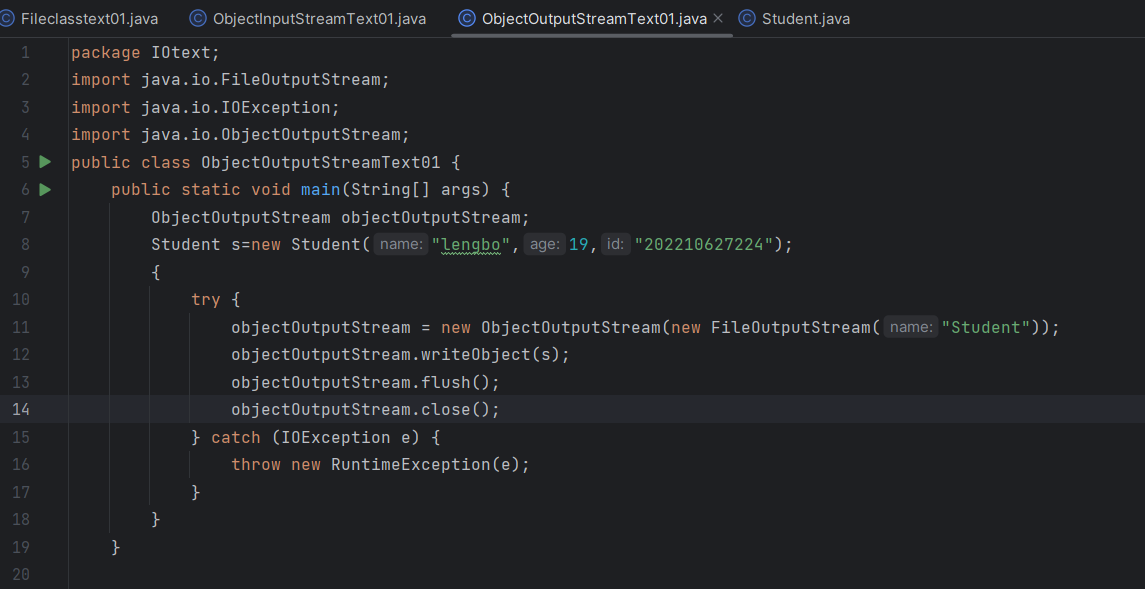
//反序列化
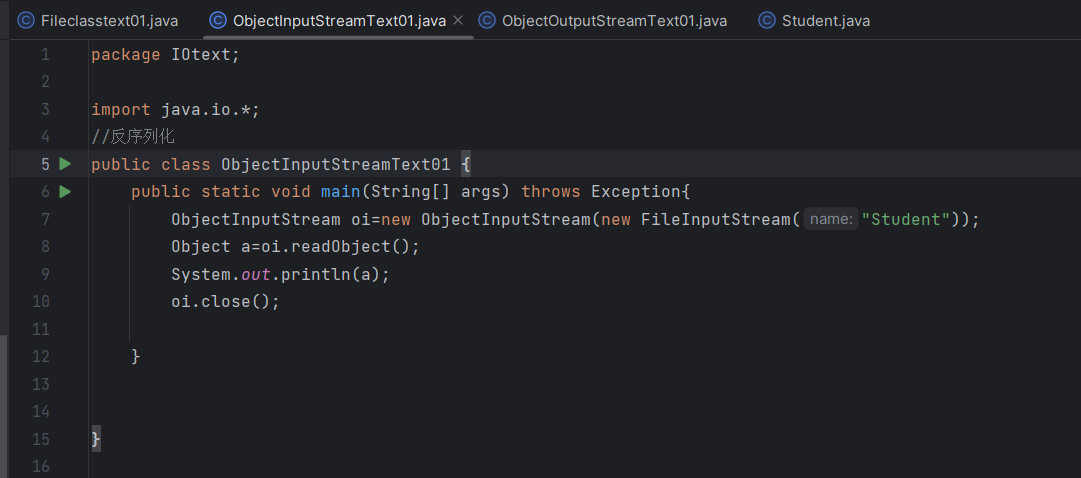
一次想序列多个对象呢?那我们就该用集合泛型了
//序列化
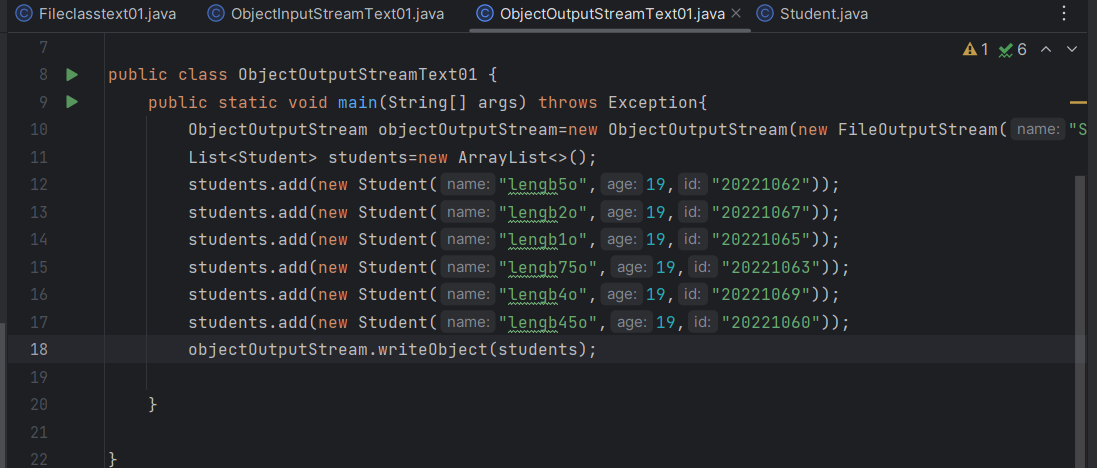
//反序列化
泛型强转
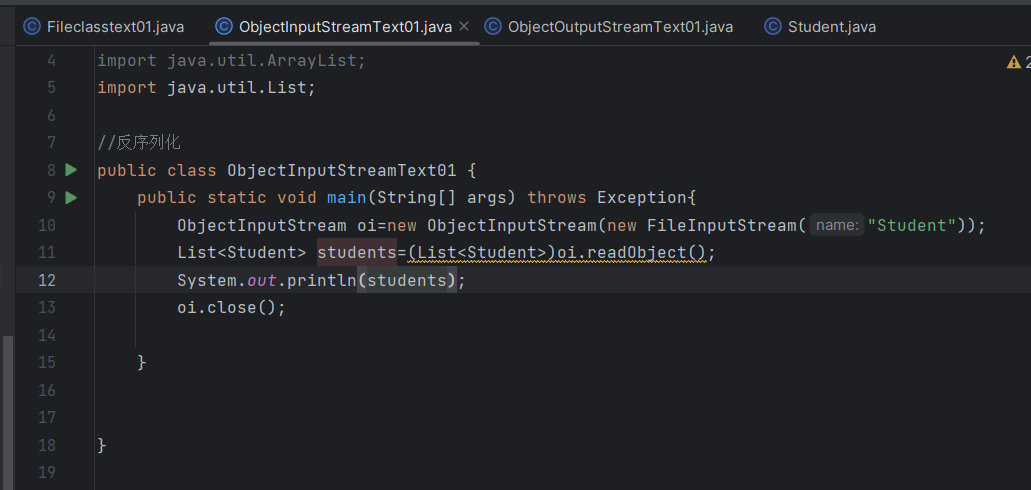
transient关键字:流离的,表示不参与序列化。
序列化版本号:
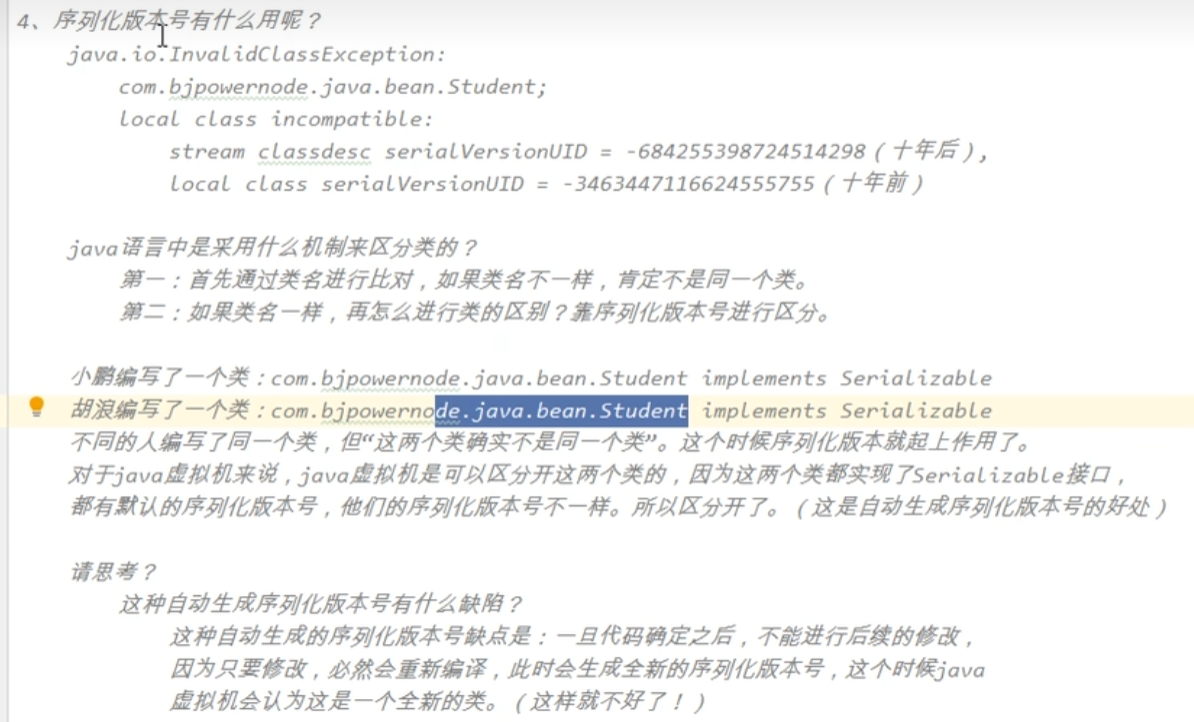
当类被修改后,序列版本号会更新,这导致反序列化时找不到以前的版本号,会出现异常,建议手动填写成常量,这样该类以后更改时就不会更换序列版本号了。
4 IO流与Properties集合连用
package IOtext; import java.io.FileReader; import java.util.Properties; //非常好的设计理念,将经常改变的数据单独写到一个文件中,使用程序动态读取,将来只需要修改文件的内容,不需要修改java代码,不用重新编译。 //类似于这样机制的文件被称为配置文件、 //通常配置格式为: // Key=value // key1:value //java命名规范要求,配置文件都需要以.properties结尾.但不是必须的,我们把以这个结尾的文件叫做属性配置文件 public class IOProperText { public static void main(String[] args) throws Exception{ FileReader reader=new FileReader("D:\\java\\javatext\\src\\IOtext\\IOProPer01"); Properties properties=new Properties(); //调用load方法将文件数据加载到Map集合当中 properties.load(reader);////等号等于=左边Key,右边是Value // 通过key获取value,key=value String a=properties.getProperty("userName"); System.out.println(a); } }
配置文件

Over!




